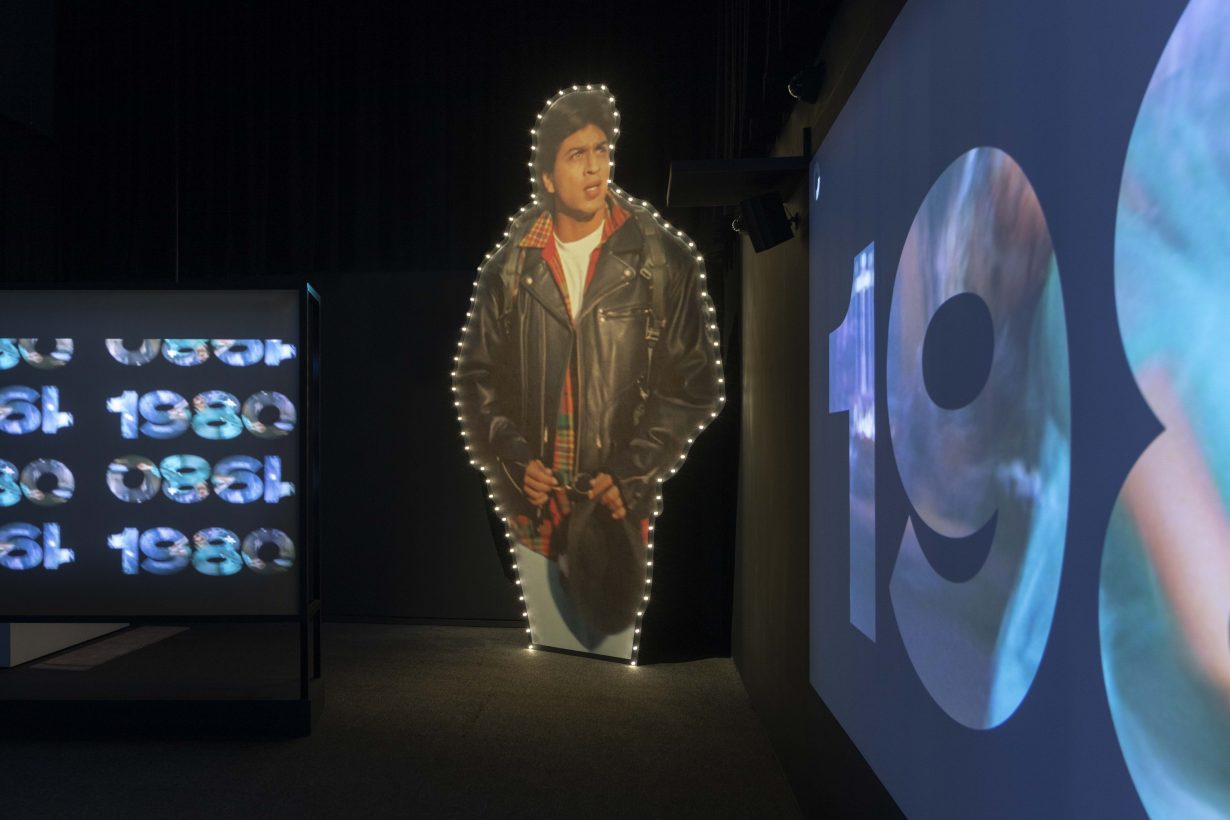A new exhibition at Louvre Abu Dhabi goes beyond Bollywood to delve into the rich history of India’s long-running movie industry, but retains an unsettling colonial undertone
On the drive to the Louvre Abu Dhabi you pass a giant electronic billboard by the side of the highway. On it, Bollywood superstar Amitabh Bachchan is advertising a competition at the nearby LuLu Hypermarket, sponsored by Kalyan Jewellers. ‘Win 3 KG Gold – 60 winners.’ He’s grinning, pointing the index finger of his right hand at the gold bar he holds in his left. We don’t need to be told who he is; everyone knows. The octogenarian has acted in more than 200 films (which led the French director François Truffaut to describe him as a ‘one-man film industry’), been the subject of more than seven biographies, won a seat in India’s parliament (during the mid 1980s) with the highest majority ever recorded, while his fellow Indian star Rajinikanth built his career on reprising Bachchan’s roles in Tamil remakes of the latter’s movies.
Bollywood Superstars is a compact show, co-organised with Paris’s Musée du Quai Branly – Jacques Chirac, to where it travels this autumn, that aims to tell the story of the origins and advent of Indian cinema (the first moving-image presentation in India took place in 1896, the exhibition’s opening text informs us, barely a year after the first Lumière Brothers screenings in Paris) through to the massive global industry it has become today. As you may have gathered from that, though the exhibition title refers to the most celebrated hub of Indian film production, the show itself incorporates work in India’s many languages and other cinematic hubs. Its beginnings, however, are occupied by various forms of religious art: from nineteenth-century Hindu temple lamps to twentieth-century painted storyteller-shrines (the doors fold out to reveal an illustrated narrative) and fabrics depicting scenes from the Hindu epic the Ramayana. There are nineteenth-century paintings of deities such as Krishna and Shiva dancing with cowherders and courtesans, bronze Natarajas (an avatar of Shiva – also the lord of actors – performing the cosmic dance) and twentieth-century photographs of classical Indian dancers and painted shadow puppets. An index, as the wall texts put it, of precinematic methods of storytelling, and the narratives that Indian cinema turned to as protests against British colonial rule gathered pace. But also an account of the gestures and poses and storylines that defined early Indian cinema. Although a cynic might say that from a contemporary perspective it’s a story of now-less-popular culture (historical artefacts of the past – some of the less-relevant items from the Louvre Abu Dhabi and other collections include Mughal armour, decorated daggers, vessels, architectural panels and boxes) made popular by an alliance with popular culture (cinema) of today. But for better or worse, it gives the show a vaguely anthropological twist, with sections on Mughal and Rajput culture thrown into the mix. There are also some curiosities (a working, decorated bioscope, a greenscreen movie set that allows you to see yourself in a Bollywood-style production) and anomalies (a woman’s dress from Pakistan – Partition being one the subjects that the show bypasses).

It’s at this stage that we begin to dive into Indian cinema proper, with a minidisplay (of photographs and videos) on the work of India’s best-known auteur, Satyajit Ray, and the ‘Golden Age of Hindi Cinema’, featuring posters of nationalist classics such as Mother India (1957). Before we come full circle and reach the show’s climax – the emergence of the new gods, the Bollywood superstars: Bachchan, Salman Khan, Shah Rukh Khan, Aishwarya Rai, etc. Many of them represented by oversize illuminated cutouts and an equally oversize recent-Bollywood-cinema highlight reel. Tucked away, on a smaller-scale screen, is Rinku Kalsy’s For the Love of a Man (2015), a documentary about four of Rajinikanth’s most extreme fans, one of whom (a former gangster) led the destruction of a cinema that refused to replay a song from a Rajinikanth movie, and another who flew from Tamil Nadu to Singapore to be near the object of his devotion during the latter’s hospitalisation. Along the way there’s a 12-day fan-organised birthday celebration and multiple professions from his avid followers that they would do anything for him (although it generally seems like they already have). And the more sinister fact that Rajinikanth, like other stars, has also leveraged his fanbase in the cause of local politics. Perhaps this, then, is the truest account of what Bollywood stardom really means.
The catalogue to Bollywood Superstars (which is in many ways a richer account of Indian movie-history than the show itself) compares Bachchan to a jeune premier and an ‘angry young man’, an act of translation that’s reflected in the fact that the exhibition itself (curated by Quai Branly’s head of Asian Collections, Julien Rousseau, and anthropologist Hélène Kessous) is captioned in English, French and Arabic; and not Hindi or any of the other languages of the films themselves. All of which gives the show a certain distanced, colonial vibe rather than announcing it as something aimed at Bollywood consumers (of which there are many in the Gulf region, as Bachchan’s advert attests) themselves.
Bollywood Superstars: A Short Story of Indian Cinema at Louvre, Abu Dhabi, through 4 June
